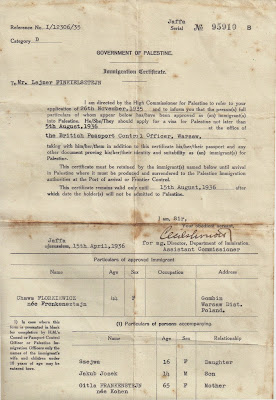 |
| The Szwarc family, Gombin (Poland) 1918 |
I have just this weekend had my first contact with another ‘new’ cousin, Belinda from Israel. This afternoon she sent me this photo of her grandparents, Towje Aron Szwarc and Bajla Frankensztajn, with 9 of their children. Two more had died young, and there was one more to come. Bajla was the sister of my own great-great-grandfather, Jankel Josek Frankensztajn, so Belinda is officially my Second Cousin Once Removed. She is named after Bajla, her grandmother.
The little boy seated on the right, whose feet don’t quite touch the floor, is Belinda’s father Pinhas (Paul), here aged about 5. In the middle at the back stands Jankel (Jack), the oldest son, aged about 23.
I had never seen this photo before, and thought it quite wonderful. Now that Belinda has identified all the people in it for me, I think that, for our family, it is also quite historic. Here’s why.
My own grandfather Lajb (Louis) Frankenstein and his cousin Jack Szwarc both left their home town of Gombin, in Poland, during 1913, and came to London. Louis was 21 and Jack 17. They may even have come together, we don’t know. They both found work in tailoring, Jack in the East End of London, Louis possibly in the West End. They both married in 1916. Jack’s first child Phillip was born in September 1917, and Louis’s first child, Esther (my Auntie Essie) was born in April 1918 (sadly, she died earlier this year, aged 95).
I have been trying to trace their lives in Britain for a couple of years now, and a couple of the documents I have come across deal with their military service during the First World War. In 1917 Russia and Britain, allies in the war against Germany, came to an agreement - the 'Allied Convention' - whereby all Russian nationals in the UK who were eligible for military service, would either have to ‘return’ to Russia and enlist in the Russian Army, or they would have to join the British Army. This included people from Poland, which was part of the Russian Empire.
 |
| Louis in the British Army |
The vast majority of the Jewish community in the East End of London had come from areas within the Russian Empire, and this agreement was particularly aimed at them. The two cousins, along with thousands of others, had difficult decisions to make. They chose different paths: Louis stayed in the UK and joined the British Army, whilst Jack opted to go ‘back’ to Russia.
Under this scheme, a number of boats, with a few thousand men in total on board, sailed from London to Odessa, on the Black Sea, between August and October 1917, and Jack was on one of those. He eventually returned to London in September 1919.
In the end, he did not fight in the War, because the Bolshevik Revolution occurred shortly after he arrived, in November 1917, and Russia immediately withdrew from the War. I do not know whether the recruits from the UK were expected to carry out some form of military service in the Red Army, after the end of the War, or whether they were freed from service altogether.
The War between Britain and Germany continued until November 1918, so Jack would not have been able to travel across Europe to return to London before then. Until I saw this photo, I had no idea where he went, or what he did, in those two years.
What the photo tells us is that he did in fact return to Gombin, some 1300km from Odessa. Belinda’s identification of the younger children dates the photo in 1918 or possibly early 1919, and Jack's presence confirms this. I think it may even have been taken especially for Jack, so that he could take it back to London as a memento of his family, and to show to his wife. It is quite probably the only photo ever taken of the whole family together. I don’t think they were ever again all in the same place at the same time.


















